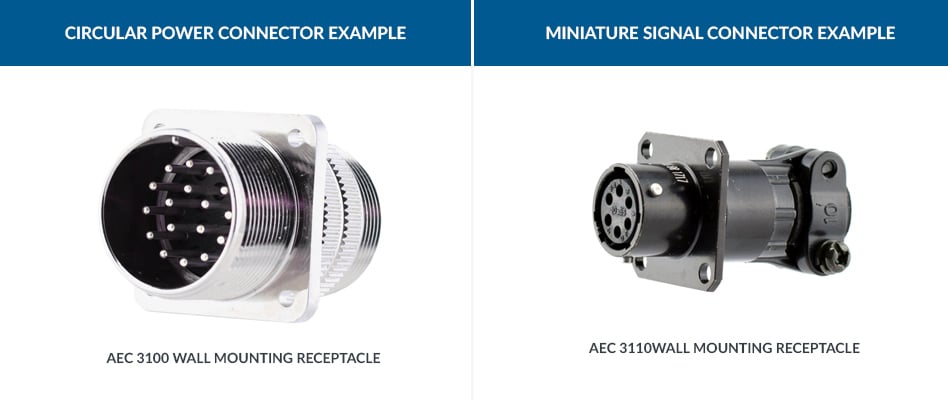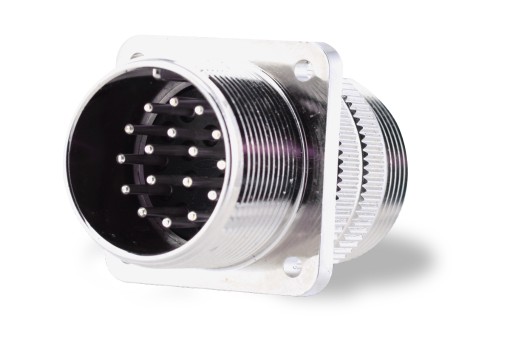A Guide to Circular Connectors
Answers to Your Questions About Circular ConnectorsWhen electrical connectors are required to power an application — be it a vehicle, machine or piece of equipment — there is a choice between rectangular and circular connectors. While rectangular and circular connectors vary in shape, their visual differences are paired with functionality differences that make each one better suited to specific applications.
As a provider of circular connector solutions, we want to paint a clear picture of the circular connector market, from its foundational elements to its future outlook. You’ll walk away with a better understanding of where circular connectors fit into your projects and how to meet the demands that come with investments in this market space.
Get Answers to Your Circular Connector Questions
Question #1: What Are Circular Connectors?
Developed in the 1930s and adopted by the U.S. Department of Defense, circular connectors are cylindrical, multi-pin connectors that feature contacts for power or signal transmission. With their roots in military applications, circular connectors are durable enough to enable secure, consistent connections in even the harshest environments.
Today, circular connectors are widely used in industrial and commercial applications that require power or signal connections.
Both deliver a similar degree of protection in extreme environments, while circular connectors are best suited for high-power or signal connections. This can be attributed to the design flexibility that circular connectors offer in terms of size and number of contacts.
Question #2: What Are the Different Types of Circular Connectors?
Circular connectors are available in a variety of contact and shell sizes, but beyond those details are the larger buckets in which this style of connector can be categorized. On one hand, you have the nature of the connection that may differentiate the connectors. On the other hand, you have the qualifications behind the connectors that also define them.
Power Vs. Signal Connectors
Circular connectors can be used to facilitate two types of connections: those designed to deliver power and those designed to deliver data signals.
Used in a range of industrial applications, circular power connectors supply the electrical current that devices and equipment need to operate. You can find these types of interconnections included in the motion systems of construction equipment as well as in wind power management systems.
Named for the small space constraints they typically must adhere to, miniature signal connectors supply the power and control that applications require to perform functions. By carrying data signals from control-oriented components to other parts of a system, these connectors drive desired output from mobile equipment and industrial machines, to name a few examples.

Mil-Spec Vs. COTS Connectors
The electrical connectors that we know today as military-standard or mil-spec connectors can be traced back to the 1930s. As the U.S. Department of Defense developed new military and aerospace applications, they established specifications for connectors to ensure that they could withstand and maintain performance in these harsh environments. Those specifications became the industry’s standard for connector design and manufacturing.
As the demand for reliable and durable connectors has become more pronounced in the commercial space, we've seen commercial off-the-shelf connectors emerge as an alternative to circular mil-spec connectors. Interchangeable with connectors on the Qualified Products List (QPL) that have been granted the mil-spec designation, COTS connectors not only save manufacturers product lifecycle costs, but they also ramp up product development as they open up the door to a wider network of commercial suppliers.
Question #3: What Are the Circular Connector Market Challenges?
The circular connector market is expected to grow significantly over the next several years, with a projected value of $114.7 billion in 2030 — compared with $62.3 billion in 2020. But we can’t look too far into the future without acknowledging the challenges that manufacturers that rely on circular connectors currently face.
Longer Lead Times
While COVID-19 may have been the catalyst for delays in the supply chain, it’s safe to say the supply chain will remain vulnerable for the foreseeable future — with variables like massive labor shortages and ocean freight congestion factoring into these disruptions. Considering the longer lead times that are already associated with mil-spec connectors, these additional delays support use of COTS connectors when applications allow for it.
Price Increases
Many manufacturers have already voiced their plans to raise their prices due to inflationary pressures, alongside aforementioned supply chain disruptions. In an effort to avoid taking a financial hit, nearly half of a group of 150 manufacturing CEOs reported raising their prices by as much as 20%.
With the need to compensate for rises in material and shipping costs, circular connector manufacturers are in a similar position where they need to pass down added expenses to their customers. These costs inevitably add up when large connector manufacturers issue requirements for minimum order quantities that exceed what the customer needs.
Customization Hurdles
Stock connectors may not be a sufficient solution for a number of reasons: they lack the protection needed in extreme environmental conditions, they fail to meet the necessary creepage and clearance standards, or they fail to meet compression requirements. As applications and their environments evolve, these cases are becoming more common.
In many cases, customers will find their requests for customization unanswered by their stock connector providers. Or if they do offer customization, they’re once again fighting a battle against higher minimum-order volume requirements or fees related to overseas production.
Visual Quality
While circular connector aesthetics haven’t always been a point of focus in military use cases, their growing use in the commercial sector has placed emphasis around a quality finish. Alongside salt spray tests to verify the connector’s corrosion resistance, there is an increased demand for scratch-resistant finishes to prevent marring to a connector’s appearance. This requires special plating, which not all connector manufacturers have.
Find Circular Connector Support in Amerline

Leveraging a rich history in military applications, Amerline has become a market leader in the circular connector industry, delivering heavy-duty power and miniature signal connectors that are tested to the same standards as mil-spec connectors. Over the course of our 40+ years, we've expanded our product lines — most recently with our AEC connector series — as well as our value-added services to meet market demands, all while continuing to provide our customers with the top quality, pricing and lead times.
This has allowed us to deliver the optimal support to the industries we serve:
Thanks to expedited delivery options, we're equipped to deliver circular connectors to customers faster than the competition.
Our process for designing and manufacturing circular connectors lends itself to pricing that tends to be 20-40% less than our competitors.
From modifications to new designs, our in-house customization capabilities let us create tailored solutions without large minimum volumes.
A scratch-resistant finish, paired with a 500-hour salt spray rating, keeps our connectors safe while adding to their visual appeal.



